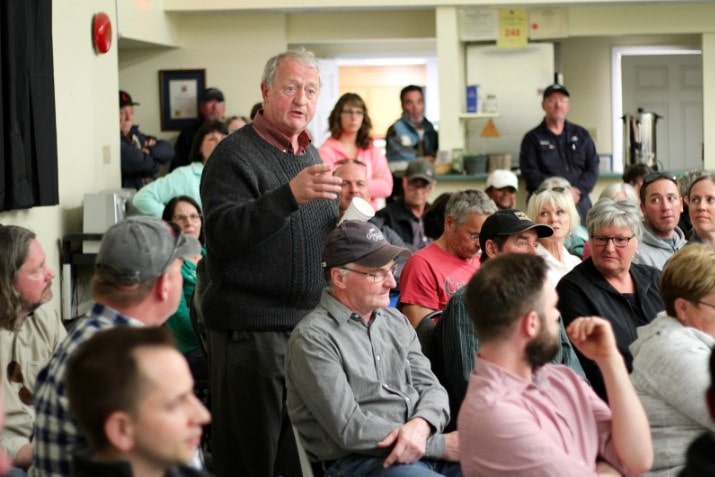KJIPUKTUK (Halifax) – Residents of the Harrietsfield-Williamswood area expressed their frustrations about a lack of safe drinking water to their municipal, provincial and federal representatives at a lively meeting last night. The event was organized by long-suffering Harrietsfield resident Marlene Brown. People are running out of patience with politicians’ non-action, and the mood was distinctly angry.

Community members are especially worried that the high rates of serious illnesses in the area, such as throat, kidney and esophagus cancer, are connected to the contaminated water they have consumed for so many years.
Despite multiple court proceedings, no health impact studies were ever conducted because residents couldn’t afford them, and no branch of government was ever willing to step up to the plate.
That reluctance by government to cough up some money continues, but the study is finally happening after all.
Environmental epidemiologist Judith Guernsey, along with a multi-disciplinary team of experts, have begun an independently funded year-long pilot study analyzing water samples of domestic wells in the Harrietsfield region. This past spring, the Dalhousie professor and her team tested around two dozen different wells and Guernsey presented the results during the meeting.
“13 of at least 20 samples had one parameter that exceeded the Canadian Drinking Water Guidelines,” Guernsey said.
Guernsey explained that in this region in particular, there are several factors at play that, in combination, caused the pollution levels to arrive at where they are now; in other words, a now defunct construction and demolition recycling facility only worsened an area that was already known to have unsafe levels of uranium and arsenic, among others.
“Our preliminary findings from samples studied to date corroborate evidence of elevated exposures to arsenic, uranium and manganese and other contaminants as well as lower pH levels in Harrietsfield residential water supplies,” Guernsey said.
Having a pH level that is lower than the Canadian Drinking Water Guidelines means firstly that the water is unsafe to drink, but also since it is highly acidic, the water itself mobilizes any existing metals such as uranium into the groundwater flow and affects the chemistry of other contaminants.
As well, Guernsey found high levels of manganese in water samples. Currently, the guidelines for manganese levels in drinking water is 50 mg/L, but according to Guernsey this is in the midst of being updated as recent studies have found that there is a link between excessive consumption of manganese and impaired brain function in children.
More work needs to be done, Guernsey said. “However, given what is already known about these health effects, a public health strategy or intervention to reduce these exposures seems prudent and should be considered.”
The community was also briefed about the long history of court proceedings, led by Lisa Mitchell, the executive director at East Coast Environmental Law (ECELaw). ECELaw has has a long history of supporting Brown and other residents in their legal fight.
- See also: A small step, but a very important step — Judge gives go ahead to Harrietsfield private prosecution
Brown’s in the midst of a private prosecution against the companies responsible in part for the environmental contamination that has occurred. Brown was the first person to file such a private prosecution to enforce the Environment Act in Nova Scotia. Yet since the public prosecutor took over the case in July 2017, it has been delayed 12 times, causing much disappointment among Brown and others hoping for some action.
“And now, we wait,” Mitchell said.
After hearing brief speeches from Stephen Adams, the district councillor for the area, Andy Fillmore, the Member of Parliament for Halifax, Brendan Maguire, the MLA for Halifax Atlantic and Minister of Environment Ian Rankin, the community members were given a chance to ask questions.
A lot of questions from the audience had to do with the lack of timeline or action plan that would ensure that this meeting was not just the politicians “giving lip service” to the community yet again.
To this day, the site has not been cleaned up, there has not been an extension of city water services to the area, nor has any water been shipped out to those with impacted wells. In the meantime, eight homes were given water treatment systems, but residents claim that the number of impacted wells in the region is much greater and more people need these systems.
With regards to an action plan, all the government representatives would say was that they had to wait until Brown’s prosecution case was concluded to proceed with an environmental assessment of the former construction and recycling site, as well as enforce the terms of the ministerial orders.
These terms include monitoring the well water of 18 wells which have been previously flagged by a hydrogeologist hired by the Department of Environment for having various parameters exceeding standards outlined in the Canadian Drinking Water Guidelines.
Minister Rankin mentioned that there are 300 contaminated sites in Nova Scotia and that “no one site is more important than the other,” but a community member later asked “how many of these sites are in residential areas?”
When no one would step up to answer, Mitchell took the microphone to best answer the question. She said that in her knowledge few, if any, of the 300 contaminated sites are in residential areas and probably zero percent of them are negatively affecting a community of 900 families’ drinking water.
Councillor Adams did say that he has requested that the 1400 block of Harrietsfield will get city water. The federal infrastructure cost-sharing model that has been proposed, according to Adams, would see the federal government pick up 50%, the provincial government take on 33% and municipal government the remaining 17%. However, this does not mean that the people of Harrietsfield would not have to pay to have it extended to their homes.
MLA Brendan Maguire said that he has put in a request arguing that residents of Harrietsfield “should not have to pay a dime” for the extension of water and sewage services to their area, “due to the circumstances.”
However, the people of Williamswood were concerned that the federal cost-sharing request only included the 1400 block of Harrietsfield. What about the rest of their community, equally impacted by the polluted construction site, angry residents wondered.
Brown agreed. Harrietsfield and Williamswood were always looked at as one community, and the request should be amended to include the homes in Williamswood as well, she stated, to resounding applause.
For Brown, despite all the layers of this issue, the “number one thing we need to take care of is the school.” Harrietsfield Elementary should have a hookup to safe drinking water, she said.
“Children should not have to be a part of this mess that we are stuck in,” Brown said.
See also: Harrietsfield homeowners win in court, but drinking water concerns remain
If you can, please support the Nova Scotia Advocate so that it can continue to cover issues such as poverty, racism, exclusion, workers’ rights and the environment in Nova Scotia. A pay wall is not an option since it would exclude many readers who don’t have any disposable income at all. We rely entirely on one-time donations and a tiny but mighty group of kindhearted monthly sustainers.




Money talks. Do they pay taxes?J